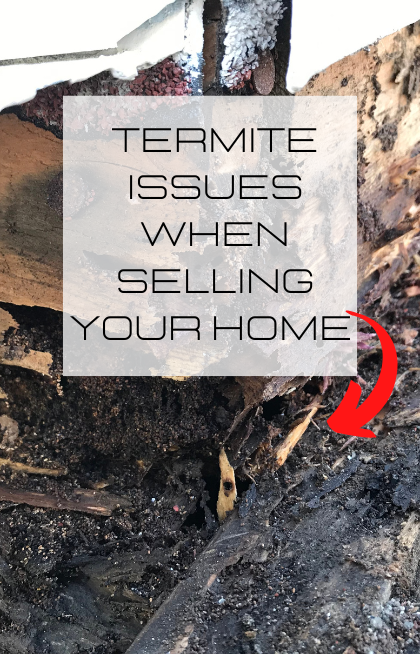CL-100 from the Sellers’ Point of View
Termites love our wet, sandy soil, but no one wants termites in their home or to buy a home with termites! Termites, wood destroying organisms and wood destroying fungi can cause a lot of damage to your home. Oftentimes, this damage that cannot be seen. This is why as part of buying a home, a CL-100 is done. Today, I am going to explain the CL-100 from the sellers’ point of view.
Contract Terms
The wood infestation report (commonly referred to as the termite or CL-100 report) is an inspection done separate from the home inspection. It is covered in Section 11 of the South Carolina Agreement to Buy and Sell. For simplicity sake, I am going to refer to the wood infestation report as the CL-100 throughout this post.
The offer indicates if it is contingent or not contingent on having a CL-100 report completed. It also indicates who pays for the inspection, who chooses the inspector and who delivers the report. If the Seller is paying for the inspection, my preference is they choose the inspector and are responsible for delivering the report. Of course, this advice is the opposite if the Buyer is paying for the inspection.
Sometimes, it feels like the termite inspection is an afterthought since it happens closer to closing. It’s definitely not an afterthought! The CL-100 report is an important part of the contract especially in areas like Murrells Inlet where termites and higher moisture content are prevalent. The inspection happens closer to the closing date because the CL-100 report is only valid for 30 calendar days. The CL-100 report cannot be dated earlier than 30 days before closing and no later than a number of calendar days agreed upon by the Buyer and Seller. Typically, I see this negotiated number anywhere from 10-15 calendar days.
What Does this Mean for the Seller?
Sometime between 30 days before closing and the date in the contract, the pest control inspector requests a date and time for the inspection to be completed. Usually, this inspection takes 45 minutes or less. You can certainly leave your house for the inspection, but you do not have to leave your house.
The inspector walks the perimeter of your property and checks the interior of your home (including your attic). The inspector looks for termite tubes, termite damage and evidence of other wood destroying organisms or fungi. They also checks moisture levels with a moisture reader in several different locations. Moisture level readings above 20% will be reported. If your property has a crawl space, the inspector will check the crawlspace. The inspector sends the party that ordered the inspection the CL-100 report. That person is responsible for distributing it to the appropriate people.
Most of the time, the CL-100 report is clear. Sometimes, however, it may show evidence of active termites or other wood destroying organisms or high levels of moisture. Should the report indicate active termites, damage by termites or other wood destroying organisms or high moisture content, the Seller is obligated to repair any issues. The Seller then provides the Buyer with a CL-100 report showing no damage or documentation that the infestation has been treated or the damage repaired.
Should the Seller not want to make these repairs, the Buyer has a few options.
- Terminate the contract. (The Seller needs to disclose the items found in the CL-100 report if the property goes. back on the market.)
- Accept the property in the current condition
- Negotiate with the Seller for payment of the repairs.
What Can Sellers Do To Prepare for the CL-100?
Preparation for the CL-100 starts well before your home is listed for sale. When you buy your home, transfer the existing termite bond to your name, or get a termite bond if it does not have one. Make sure to pay the yearly fee to keep the bond active. Your pest control company visits your property quarterly to check your termite bait stations. Some termite bonds are transferable. Add this information to your property disclosure statement when you list your home for sale.
The next thing you can do prior to listing your home for sale is to replace any wood that is damaged from wood rot or other wood destroying organisms. Definitely call a licensed contractor or structural engineer if you think you have termite damage to your home. Unfortunately, the damage from termites most often happens in areas that cannot be visibly seen.
Make a habit to check your home for termite tubes on your foundation or potential moisture or rot issues on wood. This can be as simple as taking a look at your foundation and exterior wood when you are doing yard work and checking your attic for any odd looking wood when you are getting down your Christmas decorations. If something looks off to you, call a professional.
Finally, you can choose to get a CL-100 report done on your home prior to listing it for sale. Most companies in our area charge $75-$100 for a home on a slab. It’s a small price to pay to know your home does not have any wood infestation issues.
Final Thoughts
Some Sellers believe that as long as they do not have termites or if they have a termite bond, they are fine under the CL-100 report. Now that you know more about the CL-100 from the sellers’ point of you, you know the CL-100 report covers termites and any type of wood destroying organisms. Do what you can to protect your home and hire professionals to repair any problems that you may have from termites or other wood destroying organisms.
Newsletter
My weekly email newsletter goes out on Saturdays. Information will include local market reports, real estate tips and videos, new listings of mine and my office, local business highlights, Grand Strand events and inspirational quotes.
Other articles you might like…
